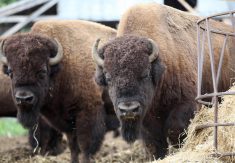With restaurants closed and exports to Europe basically non-existent, most of 2020 and nearly all of 2021 was a rough period for Canada’s bison industry.
But demand for bison meat bounced back in 2022 and prices have increased over the last year.
As a result, bison ranchers are feeling more hopeful.
“Cautious optimism? I’m starting to sound like a politician,” said Les Kroeger, who raises bison near Hanley, Sask., and is president of the Canadian Bison Association.
“I see that the industry is going to recover. But it takes time.”
The pandemic was especially hard on the bison sector because a significant percentage of bison meat in Canada is consumed at restaurants, which were closed or partly open during the height of COVID restrictions.
As well, Canada has historically exported bison meat to the Netherlands, Switzerland, and other parts of Europe. Thanks to COVID restrictions and closed restaurants in Europe, those shipments dropped to almost nothing in 2021.
So far in 2022, exports to Europe have recovered.
From January to May, Canada shipped 22,553 kilograms of bison meat to the Netherlands. That’s up 1,539 percent from 2021, when only 1,376 kg were shipped (in the same period).
“That (2021) was an anomaly that we’re hopefully never going to see again,” Kroeger said in late September at a CBA meeting in Saskatoon.
With increased domestic demand, more exports to Europe and ongoing sales to the United States, bison prices have strengthened in Canada.
During parts of 2021, bison ranchers were getting $3.50-$3.80 per pound for animals sold in Western Canada.
This year, prices are about 15 percent higher.
“Pretty close and accurate is $4.05 per lb., on the rail, for prime animals,” Kroeger said.
“It’s an increase. Not a huge increase.”
Bison producers might be cautiously optimistic about the future because bison slaughter has been flat or declining in Canada.
In 2016, about 11,600 bison were processed in the country, using Agriculture Canada figures. In 2019, 2020 and 2021, the annual slaughter was below 10,000,
Meanwhile, the number of live bison going to the U.S. has dramatically jumped.
- In 2016, 18,364 live bison were shipped to the U.S.
- In 2020, the number was 24,574 and it reached 27,986 in 2021.
- Live bison exports increased 50 percent between 2016 and 2021.
Those exports are great for bison ranchers who farm close to the border and have business relationships with U.S. buyers. However, the live bison exports caused a price gap in the market.

During parts of 2021, a producer selling an animal to an American buyer was getting $4.80 to $5 per lb., which was much higher than the $3.50 to 3.80 per lb. for a bison sold to a Canadian processor.
The price gap has narrowed in 2020, but it’s still there.
“It’s driven by the (U.S.–Canada) exchange rate,” Kroeger said.
With a weaker loonie, live bison exports jumped over the summer.
“Canadian bison imports were 35 percent higher and actual slaughter numbers were 30 percent higher than July totals,” the U.S. Department of Agriculture said in a bison market report for August.
The U.S. demand for live bison is positive, but the CBA would prefer if more animals were slaughtered in Canada to strengthen domestic prices and increase Canadian production of bison meat.
“We’ve seen some slaughter space increase. (But) it’s still enough of a limiting factor to be prohibitive to develop (some) new markets,” Kroeger said, adding this is a chicken and egg problem.
Increasing processing capacity can only happen if there’s a bigger market for Canadian bison meat, domestically and globally. But it’s hard to fulfil that demand without slaughtering more bison in Canada.
“You have to build the demand, but you have to be able to follow through with supplying the product. It’s all hand in hand.”
















